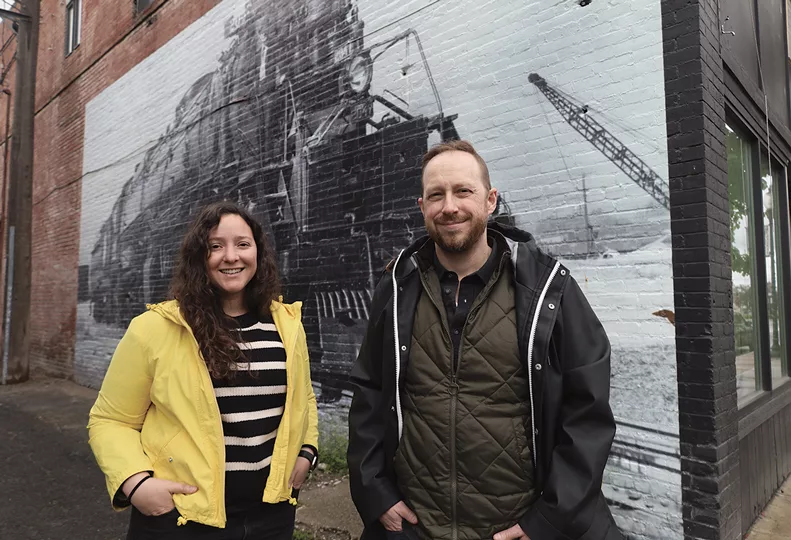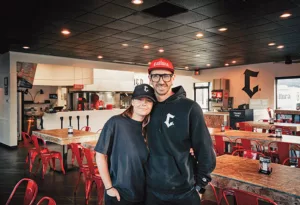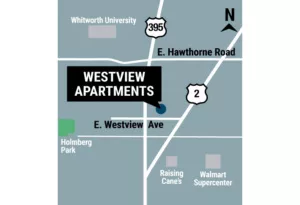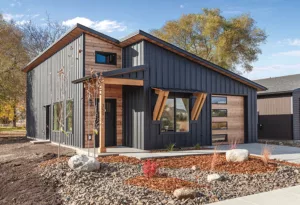
Hillyard gets creative: Spokane's first designated arts district emerges
Neighborhood on track for state designation by end of summer

Darya Pilram and Jesse Bank say Hillyard is on track to receive its state-level designation as a creative district by the end of summer.
| Karina EliasFor years, Hillyard has been shaped by disinvestment and economic hardship.
Now, thanks to a federally supported pilot initiative, the neighborhood in northeast Spokane is poised to receive the region's first creative district designation from the Washington state Arts Commission late this summer.
The effort has brought together an eclectic mix of city planners, economic development professionals, welders, muralists, and musicians in a push to reimagine Hillyard's future.
At the center of the effort are Jesse Bank, executive director of the Northeast Economic Development Authority, and Darya Pilram, a fellow in the Economic Recovery Corps, a program under the U.S. Department of Commerce.
“The high-level view is that we are establishing a state-level creative-district designation for Hillyard as a means to drive economic growth and revitalization along the Market Street corridor,” Bank says.
A creative district is intended to bring visibility, investment, and identity to a neighborhood, he adds.
“We knew we needed to do something out here in terms of getting all the businesses together, having them organized, and figuring out what the identity is, which is sort of the key to revitalizing anything,” Bank says. “That’s the thing that I’ve always found here is that everyone wanted an identity really badly, but they didn’t know what or how to get that, so this provided this incredible vehicle.”
Pilram, an artist herself who has had a 20-year career in the federal government, is tasked with developing creative districts throughout the region. Hillyard, however, is the first community that really latched on and built momentum to work toward the state designation.
“This is one pilot, in a larger bucket of things,” Pilram says. “The goal for me is to elevate people’s appreciation for the contributions that the creative economy is already making to the region, so that they’re inspired to protect it, grow it, and sustain it.”
Hillyard's potential transformation into a thriving creative district is in stark contrast to the neighborhood's origins in the railroad industry. Hillyard was established in 1892 when James J. Hill placed his Great Northern Railroad terminal outside of Spokane city limits. It served as the economic backbone for decades, employing over 1,300 people at its peak in the 1950s. The terminal closed in 1982, effectively ending the neighborhood's main economy and identity it had built from its founding.
According to a report from the National Endowment for the Arts and the Bureau of Economic Analysis, in 2023, arts and culture in the U.S. provided $1.2 trillion in annual value. Over the last 25 years, the economic value of arts and culture has doubled, even after adjusting for inflation, federal data show.
“It’s very different from setting up a manufacturing plant or construction company,” Pilram says. “But just because it’s harder to track doesn’t mean we shouldn’t try to capture all this goodness and light it up.”
Structure & Funding
In July, the neighborhood formed the Hillyard Alliance, a centralized and staffed organization that provides the organizational structure and a streamlined mechanism for engaging with community organizations, city leaders, and funding opportunities. Members include business owners, artists, and community members, Bank says. Once the alliance receives its 501(c)(3) designation, it will formally become an organization that the Northeast Public Development Authority can support long term, Bank says.
“It can be a fairly substantial line item in my budget every year and keep this thing going and retained,” he says.
Underpinning the endeavor is a $500,000 grant from the city of Spokane’s American Rescue Funds Act funds, he adds.
Signature projects
At Pilram’s first community meeting in Hillyard, which had only four people in attendance, she emphasized the potential for the community to tell its story through this state-sponsored program and build the infrastructure and resources to grow it into whatever they wanted it to be, she says.
“You have a lot of fear about development,” she recalls telling the group. “And at the same time, it’s either going to happen to you, or with you, but it’s coming.”
Pilram says that although that first meeting was only four people, it was the right four people that then told their four people, and so on. After some time, the group had identified 10 projects for the district and stopped talking and divided up into groups to tackle each one.
A few of the projects include a Third Thursday Art Walk, a decorative bike rack project, and a spate of murals across the corridor.
When the Children of the Sun Trail opened, the community noticed a lack of bike racks, Pilram says. Will Burris, the owner of Red Dragon Northside, suggested artistic bike racks, such as a red dragon bike rack in front of his restaurant and a broccoli-themed rack in front of Green’s Fresh Market.
The idea took off into a multi-collaborative project, Pilram says. The welding and fabrication department at Spokane Community College got involved with students eager to learn how to do fabrication, offering to design the racks. Will Burris donated funds toward the project, and the city of Spokane offered to match funds with money it uses for the Lime Scooter program in the city.
“We applied for one of these ARPA activation grants to match what they are bringing to the table, and now we’ve got this amazing bike rack thing that’s happening, and it’s going to involve students and the community,” Pilram says. “It’s also going to cement cycling into the business corridor.”
The mural projects are going to be scattered across the corridor. A couple will be painted by students with a professional mentor, others are going to be ‘paint-by-numbers,’ in which, during art walks, people can pay a dollar or so to paint a piece of the wall.
The Third Thursday’s Art Walk will kick off on Juneteenth and continue on a pilot basis through the summer, Pilram says. If it's successful, they’ll continue on into the winter months with holiday markets.
“We have a wait list of musicians who want to play,” Pilram says. “Almost every business on this corridor is going to host an artist. You’re going to see live music, food specials, and we’ll have vacant windows painted by professional artists.”
Pilram has also written a strategy for space activation that the entire region can use to test and evaluate different policies and incentives to repurpose or activate interesting but blighted and vacant spaces around town. She is also working on an audit of the creative talent pipeline in the region and searching for solutions to help sustain and grow it in the region.
Ultimately, Pilram and the Alliance is building a playbook with the hope that what works in Hillyard will ripple out to other districts and cities, she says.




